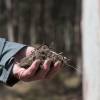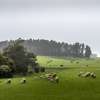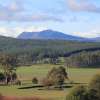
Infill plantings and remnant vegetation: Why biodiversity depends on a thriving understory
Posted 13 May 2024
On-farm benefits Tree Alliance
Creating diverse habitats for bird and insect life is an essential part of promoting biodiversity on a farm. Infill planting offers the structural variety – from ground layers, to midstory, to canopy layers – that wildlife needs to survive and thrive.
Creating a diverse understory
Conversations around trees on farms are often centred on tall trees, but the importance of the vegetation layers below the canopy can’t be understated in supporting biodiversity.
Due to grazing pressure or the presence of exotic pasture grasses, many patches of remnant vegetation do not have ongoing tree recruitment, grass tussocks or shrubs. Infill planting that includes native grasses, herbs, shrubs and small trees is vital to provide healthy habitats for bird and insect life.
Jon Finch, Entomologist at the Tasmanian Institute of Agriculture, notes the importance of creating and protecting diverse understory for wildlife.
"We really need to think about adding multiple layers to our plantings and allowing that to be undisturbed and not grazed, sprayed or managed," says Jon.
"Everything from grasses, which are important for holding soil together and providing food, to native herbs and flowering plants that produce nectar and pollen, to shrubs providing structure, shelter and food, then above that small and large trees that slow wind speed and provide shade.
"Having these diverse plantings brings structural complexity back into the landscape, which wildlife needs to survive and prosper."

Birds and insects for healthy ecosystems
Both insects and birds play significant roles on agricultural land, providing services for pest control, pollination and soil health.
"Decomposers like dung beetles turn cow and lamb droppings in the soil and revitalise it, putting nutrients back, increasing drainage and giving the soil extra structure," says Jon.
"Then predators like spiders and dragonflies keep pest numbers low and help to maintain productivity, while bees, moths and flies provide pollination services.
"All these amazing services are being provided for free."
Like insects, birds play a vitally important role in healthy ecosystems. Glen Bain, a Conservation Ecologist at the Tasmanian Land Conservancy, describes how birds offer a range of ecological benefits.
"Birds fulfil just about every ecological niche you can think of: insectivores, nectarivores, carnivores and scavengers all provide services on farms," says Glen.
"Insectivorous birds eat a lot of insects that would otherwise be a pest on crops. There’s research showing that even in orchards and wine-growing regions, their predation of insects outweighs any negative impact they may have on eating the crops themselves.
"Another benefit on Tasmanian farms is during spring, ravens will clean up any lambs that don’t make it, which stops the spread of disease.’
A challenging environment
Despite their importance to healthy ecosystems, in the Midlands, there are signs that birds and insect populations are struggling, largely due to loss of habitat.
"A lot of our native insect species require certain kinds of habitat that just isn’t provided on a modern farm," says Jon, "insects need a really diverse habitat, but a lot of areas in the Tasmanian Midlands are threatened by land-use change and climate change."
For birds, loss of habitat is paired with an increase in introduced species that are over-abundant.
"That puts pressure on native species", says Glen, "there’s just way too much competition for the number of tree hollows we have in the Midlands. The number of old trees is declining and people are clearing those trees for pivot irrigators. It’s a bit of a perfect storm."

Protecting, restoring, planting
Establishing or maintaining a healthy understory is an important part of supporting bird and insect communities.
The first step is to protect areas of remnant vegetation, which often contains vegetation of mixed ages, including dead trees and tree hollows, which are extremely rare on farms yet a vital habitat providing shelter and resources for threatened species.
In areas where tall trees require infill planting, caging individual tree seedlings for protection against browsing or damage from deer is an effective approach embraced on many farms.
"It’s about replanting areas that have degraded and protecting what you’ve got," says Jon, "think about adding multiple layers to plantations to replicate the natural environment."
"It’s really important to keep hold of old trees,’ adds Glen, "we know that having even one old tree can speed up the process of animals moving in, so plant around those or keep them in your shelterbelt.
"If you’re a farmer tidying up your farm, you can also put that debris like rocks and wood into your planting area, and speed up the process of colonisation."
A brighter future
It doesn’t need to take decades to see the benefits of infill planting. Within just a few years, bird and insect life will start appearing, and the benefits will soon follow. It’s not just about the productivity outcomes of welcoming healthy ecosystems back onto the farm; it’s also about conservation.
"The Midlands has an amazing diversity of plants, very specialised to that area and not found in many other places in the world,’ says Jon, ‘so it’s very rewarding to see landscape being restored."
"Landowners are caretakers of this biodiversity, with really deep connections to the land," adds Glen, "so it makes sense they’d want to look after it.
"We know that our reserve systems aren’t coping and that’s only getting worse with climate change. It would be so heartbreaking to know we’re losing all these species and not doing something."
For resources and advice about establishing and managing trees on your property, contact Pierre Defourny at pdefourny@tasland.org.au.
For resources and advice about establishing and managing trees on your property, visit treealliance.com.au or contact Private Forest Tasmania’s free hotline 1300 661 009





